A few pix from the 2004 Great Basin Getaway
September 16-18, 2004 - by Mike O'Brien
(Pictures are below text to allow time for your browser to load the
pictures.)
Hi all....
Well, Tom covered the food events pretty well in his post [reprinted
at bottom of page], so I will mention the operating sessions. <grin>
There were 3 operating layouts, each operating all day for one third
of the 45 guests, over 3 days. One of the layouts ended up a little
crowded for 15 guest operators, but that was OK. This "Great Basin
Getaway" was advertised with notices published on the Internet
in the OpSig email list and also in the quarterly Journal of the Operations
Special Interest Group, "The Dispatcher's Office." For example,
the April 2004 D.O. lists 14 of these regular operations events, some
annual, some biannual, all over the USA, along with who to contact.
They are pretty much first-come, first-served. So these events cater
to those of us in the hobby who want to attend operating sessions, and
who follow the Operations SIG. You can join the SIG for $15 a year direct,
or send me $25 and I will join you up. <joke>
The 3 were: Lee Nicholas' UCW, Ted York's ATSF Cajon Pass, and Gary
Peterson's SLS, all near Salt Lake City, Utah.
All 3 layouts ran by signal indication, so radio or phone contact with
the dispatcher/towerman/yardmaster was limited to getting clearances
for certain tracks and so forth. This worked well, even though we had
greenhorns running most positions. When railroad procedures are followed,
instead of model railroad inventions, experienced operators can pick
it up real fast.
We had 3 completely different command control systems. Digitrax radio
DCC, RailCommand radio analog, and RailLynx infrared direct. All worked
well enough. As you know, my local layout (Gary Siegel's L&N) has
problems with EasyDCC because it's so big. So I am especially interested
in these systems. On large layouts with many locos there is a perceptible
delay between the speed control knob and the locomotive, up to one full
second on Gary's. I asked around during our socializing time and some
delay is commonplace on all systems, except RailLynx. It was wonderful
using RailLynx for switching on Lee Nicholas' as the loco could just
nudge up to a coupler and stop with the knuckles just touching, then
nudge up some more with the knuckles just opening up and clicking into
place. With DCC you just ram into the cut of cars and hope you don't
push them too far. Ken McCorry in Pennsylvania has a huge layout which
has been NCE and is now going to DigiTrax--in the past he has used 4
different command control systems. We all love command control but it
is not yet perfected. Ted York is anxiously awaiting a newly designed
DigiTrax throttle designed to his givens and druthers for op sessions.
Lots of ideas and choices in the command control world.
Another thing I'm looking at these days is how to light a layout. There
is no consensus on the best way to light a model railroad. Sure, fluorescent
lamps are great these days, either tubes or bulb-like, but where do
you put them? The usual thing has them over the rooftops, not lighting
the sides of freight cars and locos near the front of the layout. I
don't care for backlighting of highly detailed models. Yet layouts look
good with the "museum diorama" fascias and valances. Lee's
layout had these painted black, so did Ted York's ATSF Cajon Pass, and
Gary Peterson's SLS had them painted buff color. My own plan is to have
fascias painted the color of the layout scenery (ballast green? <g>)
and not have any valances. Lights will be directly overhead of the operators
down the center of the aisles. So, bright aisles and bright layout,
with good light on the front of equipment. Give the feel of a bright
Texas sunny day with lots of scattered clouds. I saw a layout lighted
this way in Seattle last July at the NMRA national convention, Brian
Ellerby's Alaska narrow gauge layout. But there were no complaints on
the lighting of these 3 excellent layouts in Salt Lake City--or on Gary's
L&N in Santa Barbara, either.
Operations-wise, I got to use carcards on the UCW, which I like a lot.
I think Cajon Pass uses switching lists, which are more of a hassle
in my opinion, but they suit its thru trains mode so Ted uses them.
I didn't switch on the SLS, the 3rd layout -- I dispatched the first
half, then ran thru trains the 2nd half, and Gary gave me a freight
with switching to do so I would get a chance to try it but time ran
out before I got to a yard with my train. I stand firmly on the side
of carcards, even tho real RRs use switching lists. Carcards are simply
carriers of waybills, and a stack of carcards with waybills comprises
a sort of switchlist, quickly put together and easy to use.
Gary's SLS had a sort-of CTC panel made using plastic switches from
Rix Products and various push buttons on a masonite model board. I enjoyed
dispatching. The switch machines threw when set instead of waiting for
the code button, while the signals did not set until the code button
was pressed, so you could not pre-condition nor even set up a route
and wait to code it. But I quickly figured it out and got trains running.
Probably because everyone was new to the layout, it got pretty hectic
and stressful -- also because we had a few too many ops and tried to
keep everyone busy. The 2nd half I ran thru trains and got stressed
with unfamiliarity, passing red signals, not knowing what to do where,
etc. For example, at one point another train collided into my rear,
inadvertently coupling into my helper engine and pulling it off my train
and down the track a half mile. This layout has lots of hidden track
and loops where you don't where your train will reappear. At one point
I was waiting for my train to appear in the bathroom, cranking up the
speed to get it out of a tunnel, but it was actually running around
a loop in a hidden staging area under the layout! Boy could I have caused
a big wreck.
My own plans are to do as my prototype, the M-K-T in Texas, with TT&TO,
some tower interlocking, some CTC trackage, some trackage rights on
other RRs, and some dark branches. It might be confusing to my ops,
so I am a little concerned. We'll see.
Lee's UCW had a real CTC board, made by Rod Loder. Just like Gary Siegel's.
So mainline trains run on signal indication. I also ran on a branch
with "manual blocks" which was just like DTC, tho short so
there were only 3 blocks. Telephones are used to get blocks, no radio.
Very nice.
DCC and RailLynx allow sound systems, which are really, really, really
nice for op sessions as a feedback device for running trains. A must
have, really. Besides being fun to whistle at road crossings. These
new Broadway Limited sound-equipped locos will advance the hobby by
making sound systems routine. Ken McCorry said he tests response time
on his huge DCC Pennsylvania layout by seeing how quickly he can send
whistle commands.
Scenery on all 3 layouts was beautiful. I think 2 of them will be in
the Great Model Railroads issue due out soon. Ted York has delicate
models and would not normally allow visitors to run them, to preserve
handrails etc. So he has rules: do not touch the models. Do not lift
up cars to uncouple them. Do not rerail wrecks, call him to do it (not
that there were any wrecks, it all ran perfectly). Do not reach into
the layout, knocking over signals, buildings, etc. These rules are OK
because the railroad deserves the respect, it is gorgeous.
Multiple decks. Lee's and Ted's were mostly one deck, tho Lee had an
upper deck branch line. Gary's had multiple decks -- as many as five
in places, and single deck in other places. It got pretty confusing
to someone new to it, as we boomers were. I am planning on three decks
on my RR, with the 3rd being minimized kind of like a "basement."
So I will have 2 main decks. I want them aligned along the front, or
"fascia." None of these 3 layouts were like this, but I remain
pretty sure of myself on what I want to do. This is an issue on which
there is no general consensus on how a model railroad should be. Obviously
single deck is best, unless the mainline run is too short. Then we start
compromising, with many variations possible. Ted York did not have to
compromise, as he has a huge basement. Lee Nicolas keeps the single
deck feel while often having two lines nearly parallel in one scene,
very successfully. This seems to violate the "sincerity" principle
but it actually works very well here. Gary Peterson mostly maintains
sincerity but extends the run with multiple decks and hidden loops,
adding complexity and extending the learning curve. Operating a big
model railroad has enough interest to get 45 guys to travel hundreds
or thousands of miles -- we had several guys from the east coast --
so a readily understood track plan is an advantage. I may have to rethink
my plans to add several potentially confusing branch lines to my linear
track plan. I am designing my own model RR with the idea that it can
accommodate boomer op crews such as we had in Salt Lake this week.
Crew lounges, dispatcher offices, and such. Lee had a dedicated one
right near the crew caller position, which seemed optimal. Ted used
his breakfast room upstairs. Gary had a basement family room surrounded
by staging yards, which everyone who used the sofa hit their head on.
2 of the layouts had dispatcher offices, the 3rd did not have a dispatcher.
I am planning on having these upstairs, since I wanted the layout to
be a big as possible in the basement. Everyone loves Lee's crew lounge
right at the RR. Oh well. By the way, Lee's has a ceiling height of
about 6 feet, so I have to tilt my head, but we all put up with it.
His RR has 6'-3" headroom but is OK for almost everyone, so a low
ceiling height is no deterrent. Sorry you tall guys.
What else. Like Tom, I loved the food events put on for us, barbeque
etc. Very well organized, thanks to Lee Nicholas. Great to socialize
with my MRR friends from other cities, gossip, etc. Shared a hotel room
3 ways, so it was inexpensive. Drove to SLC from LA, over 700 miles,
with Tom Turner. We carpooled a lot, visited hobby shops in odd moments,
railfanned, you know how it goes. A great time had by all.
Cheers,
Mike O'Brien
Pasadena, CA

Here's the famous "Mole" at Lee's UCW. Two men run it. Run-thru trains stay on a staging treack, but all other cars get put on shelves, along with their carcards and waybills. Trains with switching are assembled from the shelves. Access to this room is only by crawling under the layout. Carcards and sent to and from the other end of the layout with a clever downhill trolley system. Tracks from here feed onto each end of the modeled RR mainline division at major yards. Robin Becker in the back is from Orange County, CA while John Dulaney in the front is Lee's visiting main mole from Portland, OR.

Lee's UCW has the museum diorama look. Valance above and fascia below are black. Aisle is unlit. Layout lighting is fluorescent bulb-lamps spaced every couple of feet. Hot spots in lighting are not objectionable in real life, tho visible in photos.
Barely visible in the darkness below the scene are the carcard box with 2 compartments, and to its left are two clips on hooks one of which has a red card which holds "PM Setouts." The empty clip would have held AM Setouts, which have already been made. This is an interesting fillip to the carcard system that Lee has developed, in which the person staging the layout between sessions determines which cars get spotted by the AM or PM crew. Tom Turner was impressed by this idea and will implement it on Gary Siegel's L&N in Santa Barbara.
Jim Senese is demonstrating uncoupling posture, reaching to the back of the layout with a pick. Jim's KC Bottoms layout near Tulsa, OK is hugely influential in the hobby. Both Chuck Hitchcock and David Barrow have implemented switching layouts influenced by Jim's ideas.
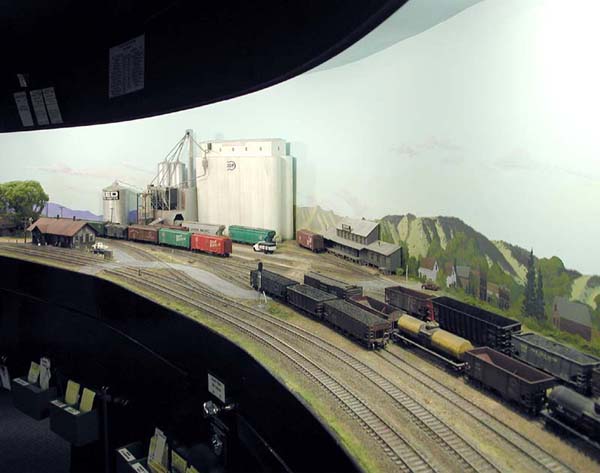
Lee's UCW is beautiful, even tho it is mostly just a long shelf layout. At this station a branch line joins the CTC controlled main line. You can see the switch this side of the station. This switch has either dispatcher control or local control. When the dispatcher, on the telephone, gives you local control, you insert the key hanging on the hook in the lock to activate your turnout control levers. This is all located on the fascia just below the switch -- you can see the white sign there, with the levers and key below it.
The usual carcard boxes are seen at the bottom of the fascia. Also, note the carcards barely visible on the valance above the layout scene -- there are 3 of them set into a plastic strip provided for temporarily organizing your carcards so you don't have to set them out on a little table or, god forbid, on the layout scenery.
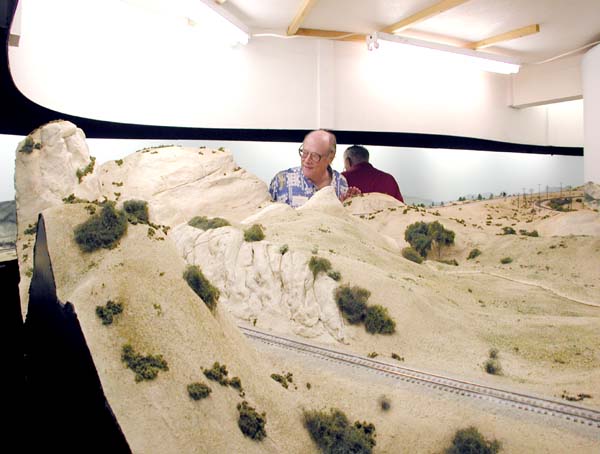
Here's a bald guy from Pasadena sticking his head into Ted York's Cajon Pass layout. They tell me his name is Mike O'Brien. I see him in the mirror every morning.
This is the Sullivan's Curve scene, with the famous big rocks between the track and aisle. Ted's scenery is of course absolutely wonderful. This layout is on the cover of the 2005 Great Model Railroads. Note the use of fluorescent tubes in the usual way, just like Gary Siegel's L&N. You can see the great contrast between the black fascia and valance and the well-lit layout scene. This area is a big blob. No, I'm not criticizing it, that is what a turnback loop at the end of a layout peninsula is called. This is mostly a shelf layout, but at this blob it gets big and deep for a grand scenic highlight in Cajon Pass.
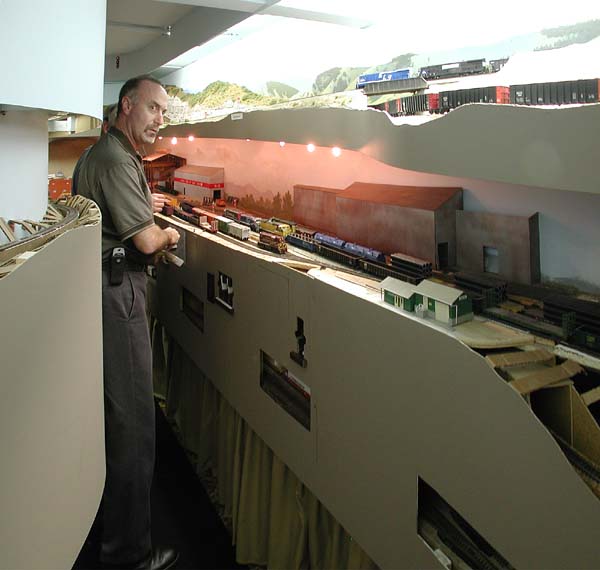
Here's Robin, the guy we saw in the Mole at Lee's. He's been let out on the mainline at Gary Peterson's SLS. He's at a choke point in the aisles where it gets too narrow to pass, which is probably why he's looking at me that way, I hope. No, Robin, you don't have to get out of my way, I'm just taking your picture.
Note the color of the fascia, a nondescript color which is good for being visually unobtrusive. Note the multiple decks, with the upper deck recessed at the busy station area below. A 3rd deck is below, visible thru rectangular openings cut in the fascia -- this is actually a multiple track staging area. A 4th deck is coming out of the unscenicked tunnel mouth at the far right of the photo, just below the main lower deck. A 5th level is the blue loco on the girder bridge up near the ceiling. Finally, note the smallish valance visible above Robin, which hides fluorescent lamps. The lower deck here has supplemental lighting from rope lights which are sagging into view in front of Robin and only cast a little red glow onto the backdrop.
With 5 levels of mainline here, and no room for ops to pass, there is a lot of congestion. All the ops kind of mill around in the wide areas of the aisles watching their signals. The signals are pointed towards the operators where necessary, instead of down the track.
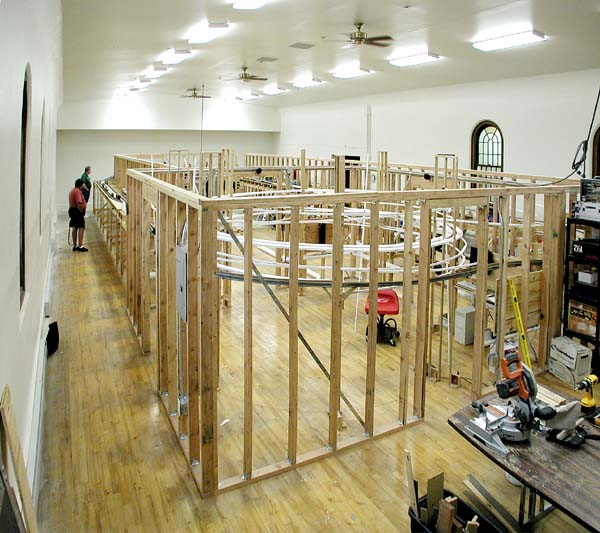
As an extra event, we visited the layout in progress of Jon Robinson in SLC. He lives in an old church building which is huge. You can see how big his layout room is. There is another wing as big as this one, plus full basements under everything. This layout is planned to be two stories high, so is built like a two story house in the middle of the room. The 2nd story is not built yet. This corner has the helix. It is O scale. Jon may switch to HO for a longer run, he says. You can never have enough, right?
We had a catered buffet dinner from P.F. Changs, which was excellent. All 45 of us fit in one corner of his living room, in the other wing of the building. Where can I find an old church???
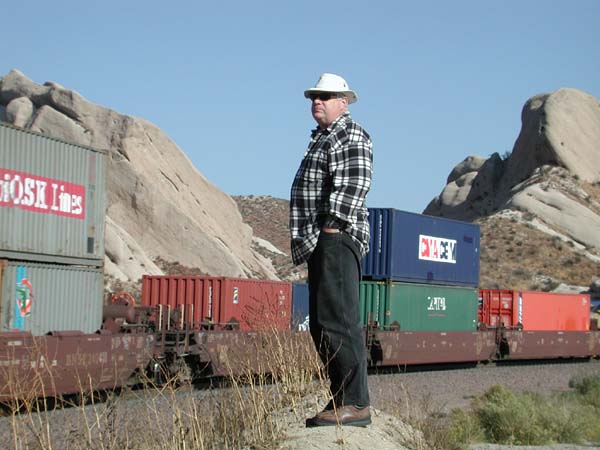
Tom Turner and I railfanned Cajon Pass on the way home. I-15 runs thru here and also thru Salt Lake City. It was especially interesting to be here, after being at Ted York's model of the same place. The scale is different. Really. Not just HO versus full size, but the real place seems vast, with mountains thousands of feet high, while the model has mountains hundreds of feet high. Hey, but what can you do in a basement?
Below is my traveling companion Tom Turner's brief report
Hi ...
Well, of our membership [Gary Siegel's L&N crew], Mike O'Brien, Bruce
Morden and Greg Drummond attended. Andy Sperandeo, Doug Geiger, John Zach,
Steve Hayes and about 40 others were there as well. Lee Nicholas, who
is a member of this list, was our host and creator of the event. We had
great times all three days running the layouts that I discussed before.
Besides the daytime operations, we had some great get-togethers. Thur
evening we ate at the Prarie Schooner in Ogden which is a world class
eatery. Friday evening we were all invited over to Jon Richardson's 15,000
square foot home for dinner and to review his layout beginnings (An elevated
circle of O-Scale track about 45 feet by 30 feet in the middle of a much
larger room.) His wife gave us a tour of their home after dinner. Truely
amazing. It used to be a Mormon church and then it was a Catholic church.
Jon bought it and is rebuilding it as a home. Fascinating project. Have
you ever considered what you would do with your layout if space were truely
not a limiting factor?
Saturday we had a big get together at Lee's for the catered barbeque.
It was outstanding - even better than the 'Schooner. After saying our
goodbyes, Mike and I started driving towards home trading off driving
and sleeping chores. In the morning we found ourselves at Cajon Pass with
nothing to do for a few hours. (funny how that just 'happened',) We hadn't
even gotten out of his truck before the first container freight blasted
by uphill on the UP. Before it was out of sight helpers ran down the hill
whistling the grade crossings every few seconds. Then a pig train came
along just behind the container train. A BNSF on the higher track was
headed downgrade away from us so we jumped in the truck and went out on
the highway. We doubled back and paced it and several other trains before
finally leaving the area. We saw about eight trains in the hour or so
we were there. A quick stop at Longs, Moreno Valley and then Mike and
I drove to our homes.
I'm glad that I didn't fly up to the event because Mike and I had lots
of time to discuss what we had learned while operating those layouts.
The biggest thing that will affect our operations is the 'SPOT' cards
that I discussed in my earlier email. I will also be changing some of
the identifying information around Gary's layout and have recommitted
myself to limit the involvement of road crews participating in the staging
and retrieval of trains from staging. My commitment to work on the CMRI
and to deal with the poor engine performance has also been reinforced.
I think most of you who operate with us will find that you are glad that
I went to these sessions.
Bruce and Greg are camping their way to Colorado Springs for the Rocky
OP. Wish them luck as Mike and I drove through two terrible storms on
the way home last night. Two storms that were headed for the mountains
of Utah and Colorado. Lightening, torrential winds and hail, oh my.
Gotta go,
Tom